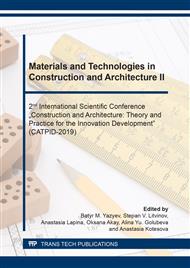p.49
p.55
p.61
p.67
p.75
p.83
p.90
p.96
p.101
Reasons of Blooming on Light Clinker Paving Bricks
Abstract:
The paper presents the results of the research for the reasons of the formation of a brownish bloom on a light clinker brick during its operation. In the work course, the clinker bricks, their mineralogical composition, the nature of the secondary brick coloring and the base materials were tested during bricklaying. It was established that 2 factors caused incrustation. Firstly, the site on which the clinker brick was laid was characterized by a level of alkali soil water close to the surface, and the surface evaporation prevailed over the soil absorption in the warm period of the year. That is all soil water-dissolved salts migrated to the surface of the brick along well-permeable sand joints between the bricks. Secondly, ferrous minerals, including hematite, which was subjected to hydration with the formation of iron hydroxides, and also reacted with sulphates of groundwater with the formation of iron sulphates, were found in the foundation under the brick. This confirms the higher sulfur content in incrustation areas and the presence of a film similar to crystalline hydrates. The analysis of the research allowed us to develop the recommendations for the performance of paving various types of sites with clinker bricks, to develop measures to eliminate an existing bloom, and also to defend the “honor and dignity” of light bricks.
Info:
Periodical:
Pages:
75-82
Citation:
Online since:
December 2019
Authors:
Keywords:
Price:
Сopyright:
© 2020 Trans Tech Publications Ltd. All Rights Reserved
Share:
Citation:


